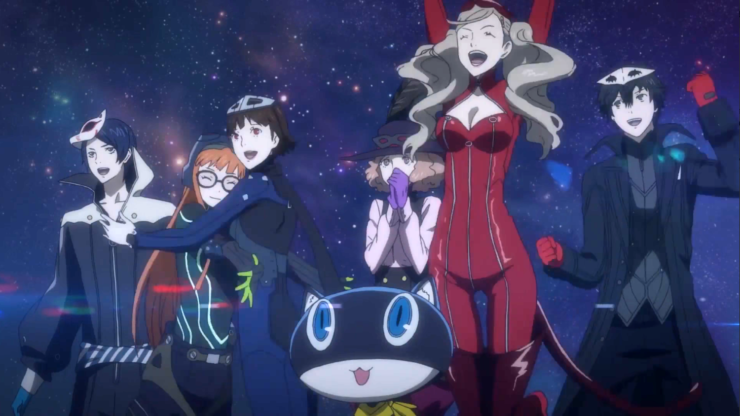You’re an ordinary high school student exploring a strange magical palace with your friends. You find a garish throne room adorned with giant ass-shaped statues. And suddenly, to your surprise, you are doing battle with a massive green choad.
Literally. It’s a giant green dick. It’s named “Torn King of Desire.” You have to kill it using a combination of fire, lightning, whips, and knives. A talking cat with a slingshot helps you.
And it is very, very satisfying when you succeed. You’re ready to take on the world. This is victory.
No, it’s better than victory. This is justice.
…Okay. Let me back up a bit.
There are a million stories about teenagers saving the world. It’s a media mainstay that never seems to go out of style, for all that people love to gripe about its prevalence. In books and movies, manga and anime, TV shows and games, we love stories about meddling teens taking down all kinds of evil, from unfriendly local vampires to sprawling space empires, from school bullies to corrupt political systems, from masked serial killers to literal gods. It was popular even before YA became the juggernaut marketing category it is today—and that status brought along a whole ecosystem of detractors and critics—and I’m sure many PhD candidates have written very nice theses on the topic that I have not read.
There are good reasons the teens-save-the-world trope is as widely critiqued as it is beloved, as it is perfectly natural to ask questions as a story draws you in: Why are all these immense problems the responsibility of children? Why do the mystical forces of fate pick attractive sixteen-year-olds as the chosen ones? Can teens even do that stuff? Do they even care? Aren’t there any adults around? Who’s watching these kids? Isn’t it dangerous? Where are their parents?
Good questions. Worth asking. Where we run into problems, however, is when we decide that the mere existence of these questions means the stories can be dismissed as silly kid stuff that adults need not bother engaging with. It’s up to each individual story to decide how well those questions need to be answered, or if they need to be answered at all. How the story answers, or doesn’t, can prompt us to think about what kind of story we are experiencing, what that story has to say about young people, and what it is saying about our world as a whole.
Something I think about a lot, as somebody who has written YA books, loves YA media of all stripes, and most importantly lives as a human person in this very flawed world of ours, is this: Why do we always put teenagers in the position of saving us from ourselves?
And that brings us back to where we started.
Back to fighting a giant green dick.
With the help of a talking cat.
That’s where we started.
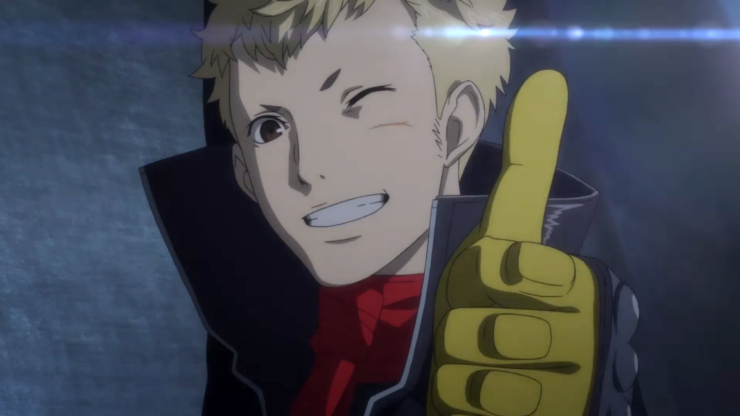
Persona 5 is a JRPG from Altus that was first released in 2016, then updated with more story, more characters, and some much-improved game mechanics in 2019’s Persona 5 Royal. It fits neatly into the broad category of politically-minded YA fantasy and SF; it’s about a ragtag group of teenagers who have to save the world by facing down corrupt people in positions of power. There is some high-concept mystical-chosen-one-fate stuff going on—it’s complicated—but what’s most interesting is why this huge pile of responsibility falls on a bunch of misfit teens in the first place.
The reason is, quite simply, the adults won’t do it. Far too many adults in their lives are too invested in maintaining their own comfort and power, or too ground down into weariness and resignation, to shake up the corrupt world in which we live.
You play as a male Japanese teenager who eventually acquires the code name Joker. He gets into trouble in a very typical YA protagonist way: by trying to do the right thing in the wrong place at the wrong time. He’s walking innocently down the street when he sees a drunken man hassling a woman. Because he is a good kid, albeit in that silently blank RPG protagonist way, he steps up to tell the drunk to back off—not knowing that this man is powerful, cruel, and protected by the corrupt cops. So Joker’s good deed turns into a nightmare when he is convicted of assaulting the man and sent off to live in Tokyo for a year on probation.
On one level, this is the basic backstory necessary to get a teenager living in Tokyo without parental supervision. On another level, however, it is a preview of the game’s themes: The powerless in society are harmed when the powerful misbehave. The world is not fair. Truth does not set you free. It really, truly sucks to be a young person in a world full of shitty adults. How these themes develop is a big part of what makes Persona 5 both a fun game and a compelling YA story.
The gameplay is a combination of social interaction and dungeon crawling, where Joker divides his time between going to school, hanging out with his friends, expanding his social circle, watching TV, going out for ramen, working part-time jobs, all while accompanied by a slick, sexy jazz soundtrack. (The soundtrack is so cool you will become 113.9% cooler just by listening to it.)
And, oh, he also keeps busy sneaking into the violent subconscious minds of corrupt and abusive adults to force them to be better people.
You know. Normal teenage stuff.
On Joker’s very first day of school, he and a new friend find themselves lost in a strange, vaguely psychedelic fantasy realm in which a grotesque castle has replaced the high school. There are monsters prowling the corridors and students in cages in the dungeon. Lording over it all is a nightmare version of the high school’s star athletic coach, a man named Kamoshida. In this dream-like realm, the coach is dressed in nothing more than a crown, a velvet cape, and Speedo, and surrounded by sculptures of female anatomy and portraits of himself, which is every bit as revolting as it sounds. With some helpful exposition from a talking cat, Joker learns that this fantasy realm is called the “metaverse,” and the castle represents how Kamoshida views his own world: He is the all-powerful king of the school, and students exist only to be tortured and enslaved as his groveling subjects.
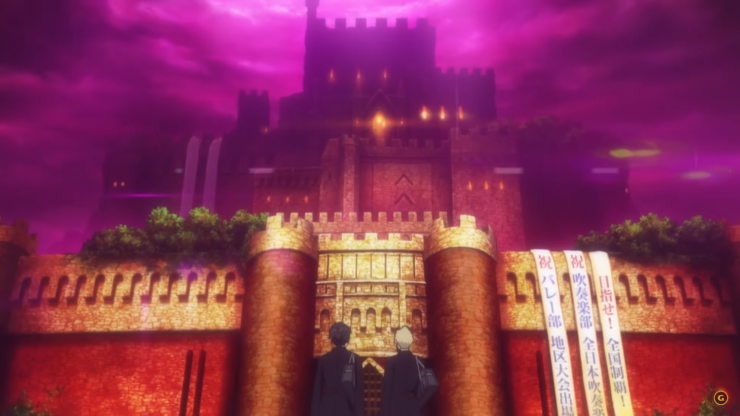
It turns out this grotesque fantasy realm exists because it is the twisted version of what’s happening in real life; the way some people conceive of the world and their place in it is so distorted that they create entire fantasy realms with the power of their delusions. In real life, Kamoshida regularly abuses and harasses students, but he is protected, king-like, by the negligence and complicity of school officials. Joker’s first friends are among Kamoshida’s victims: a former track star turned social outcast who stood up to the coach and suffered a violent assault in retaliation, and a biracial model who suffers relentless slut-shaming from other students while trying to negotiate the coach’s sexual harassment to protect a friend on the volleyball team. (Aside: On the subject of very nice PhD theses, who’s going to give me a degree for writing tens of thousands of words on the topic of “Ryuji Sakamoto: Best Boy and Perfect BFF and Most Precious Cinnamon Roll Who Ever Swung a Nail-Spiked Bat at a Giant Green Dick”? I am ready. I can argue my thesis thoroughly.)
Along with that helpful talking cat, these three kids explore the mental palace that Kamoshida’s delusions have created deep in his subconscious. They discover that within this realm they have their own magical abilities, and they can use those powers to alter the inside of the man’s mind. They can make him stop. They can make him atone for all the harm he’s caused. They can make him sorry.
That is a terribly alluring power to put in the hands of a bunch of badly mistreated teenagers.
Everything about Persona 5’s first villain is distressingly mundane and, as a result, incredibly effective. The phantasmagorical mind palace may be new, but we’ve all known men exactly like Kamoshida in real life. He’s everywhere. He exists in the coaches who are too rough on boys, the teachers who too familiar with girls, the has-been heroes who have a strange circle of acolytes and a Teflon ability to shake off any real consequence. We’ve met him in our schools, our places of work, our churches, our police departments, our online communities. We’ve elected him into our government. We’ve watched men like him gain and keep power in every level of every social and political system by trampling on everybody in their way.
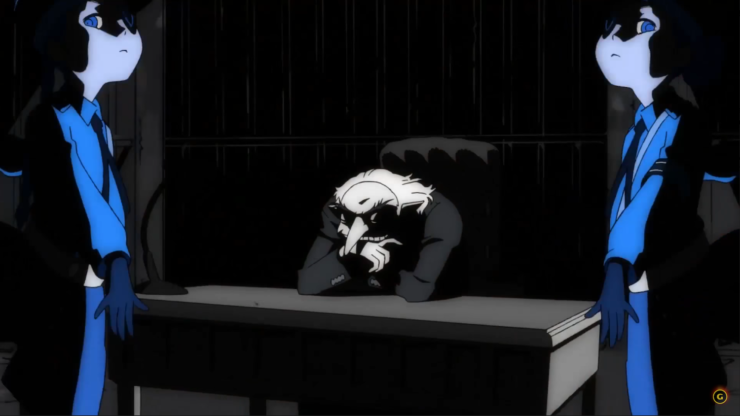
This familiarity is absolutely key to the story’s success. The game does not jump straight into the world-shaking problems. It gets there, eventually, in increasingly weird ways, but it starts on this small, personal, and devastatingly intimate scale. It starts with abused kids fighting back against the man who hurt them. The world that Joker and his friends are initially trying to save is, at first, no bigger than one ordinary Tokyo high school, a microcosm suffering under the thumb of a single violent man.
Only after they are successful do they set their sights higher. Now calling themselves the Phantom Thieves, the kids and their talking cat look for other abusers to take down. They bring more kids into their little family of daring mind thieves, and their circle of acquaintances expands to include all kinds of people from the neglected fringes of society (an ex-Yakuza shop owner, a back-alley doctor, a teacher moonlighting as a rent-a-maid, and more). Not all of the adults in their lives are awful or clueless; some just require a little nudge to get them to help. From the very first encounter in the fantasy realm, one thing remains absolutely clear: This is not a fight that anybody can win alone.
The gameplay is structured as a series of increasingly daring heists, with all the usual steps: getting the team together, acquiring targets, carrying out infiltrations of endlessly bizarre mind palaces. Visually, there is constant flux between the real world and the so-called metaverse of their fantastical adventures. The latter is made up of beautifully rendered Tokyo neighborhoods, with coffee shops and schools and bathhouses, parks and restaurants and subway cars crowded with suited salarymen. The metaverse, on the other hand, is portrayed as a series of nightmarishly whirling, shifting, magical scenes, filled with flaming monsters lurking around every corner, tunnels that pulse like viscera, and mazes that operate on the dream-logic rules of whatever villain is embodied within them.
The Phantom Thieves begin taking on more numerous and more powerful targets; bullies, stalkers, and controlling parents lead to celebrities, organized crime bosses, and CEOs. The kids may start out worrying about being expelled from school, but the stakes creep continually upward, level by level, battle by battle, character by character, until they learn that the consequences of their actions are genuinely cosmic, and they are in way, way over their heads.
The progression is not subtle, but it doesn’t need to be. The core of the story, the entire framework on which it is built, is the belief that the abuse and mistreatment of young and vulnerable people is not a childhood problem or a school problem or a teen behavior problem. It is nothing less than a pervasive sickness at the very heart of a society. Left to their own devices, the cruel and powerful will not change. They have too much too lose, too much invested in their own status and power. So we have to force them. We take away their choice. We sneak into their subconscious minds and fight until they feel bad about what they’ve done.
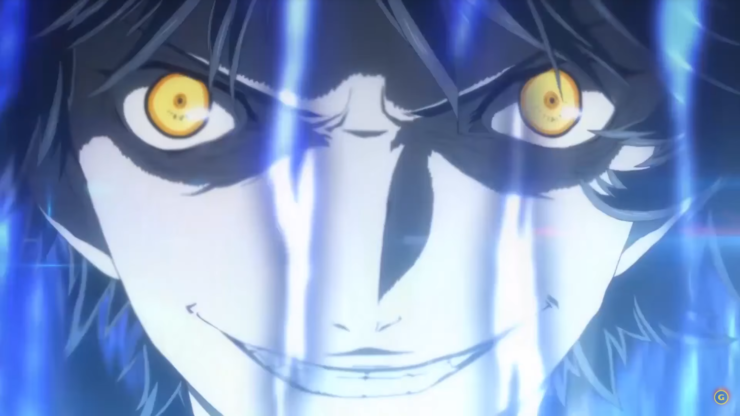
It is a fantasy of ultimate wish-fulfillment because, alas, changing the hearts of shitty people is never that easy. That is the hard reality every real-world kid runs into when they realize that adults are fundamentally flawed—and, even worse, that many adults don’t much care to fix those flaws.
Let’s be honest: whether you’re young or you’re old, if you had the power to magically force the very worst people you know to feel awful about and take responsibility for the harm they’ve caused, wouldn’t you at least consider it? Would you really be able to resist using that power? What if you could use it on the people who abused or assaulted you? On criminals who prey on children? Or, say, politicians who stood by doing nothing while hundreds of thousands of people died in a pandemic?
Persona 5 is a Japanese game, created by a Japanese team, grounded in Japanese culture, and inspired by Japanese political events, all of which are incredibly important to the nature of the story. But the theme of dealing with harm done to young people by adults in positions of power is universal. It is the lifeblood of so much YA media and fiction around the world precisely because the teen years are when we become aware that we’re struggling within a system that is rigged against us.
Buy the Book
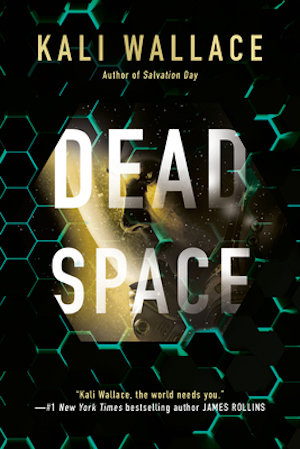

Dead Space
Good political YA SFF naturally reflects this frustration and vulnerability young people feel. It shouldn’t make us ask, “Why the hell are teens the ones saving the world?” but instead, “Why the hell aren’t we doing it so they don’t have to?”
It should make us consider, as well, how the world in which we live is unfair down to its bones, and that means the choices presented to us, or to the plucky teens we play in video games, are often imperfect and limited, but we are still responsible for making them. We can speak up and take a stand. We can find our people and keep them close. Make friends with the precious cinnamon rolls everybody else dismisses, scorns, and bullies. Build a family of friends and allies. Never trust the rich and powerful. Work with the marginalized and disenfranchised instead.
You don’t start out by saving the whole world. You start by protecting the kids right next to you from the abuser right in front of you.
Learn to be kind and smart and resilient. Make good coffee. Let yourself heal when you are injured. Go to bed when the day is over. Stomp on the dicks of rapists every chance you get.
And if you can, do it all with the help of a cool jazz soundtrack and a talking cat.
Kali Wallace studied geology and earned a PhD in geophysics before she realized she enjoyed inventing imaginary worlds more than she liked researching the real one. She is the author of science fiction, fantasy, and horror novels for children, teens, and adults. Her most recent novel is the science fiction thriller Dead Space. Her short fiction has appeared in Clarkesworld, F&SF, Asimov’s, Tor.com, and other speculative fiction magazines.










